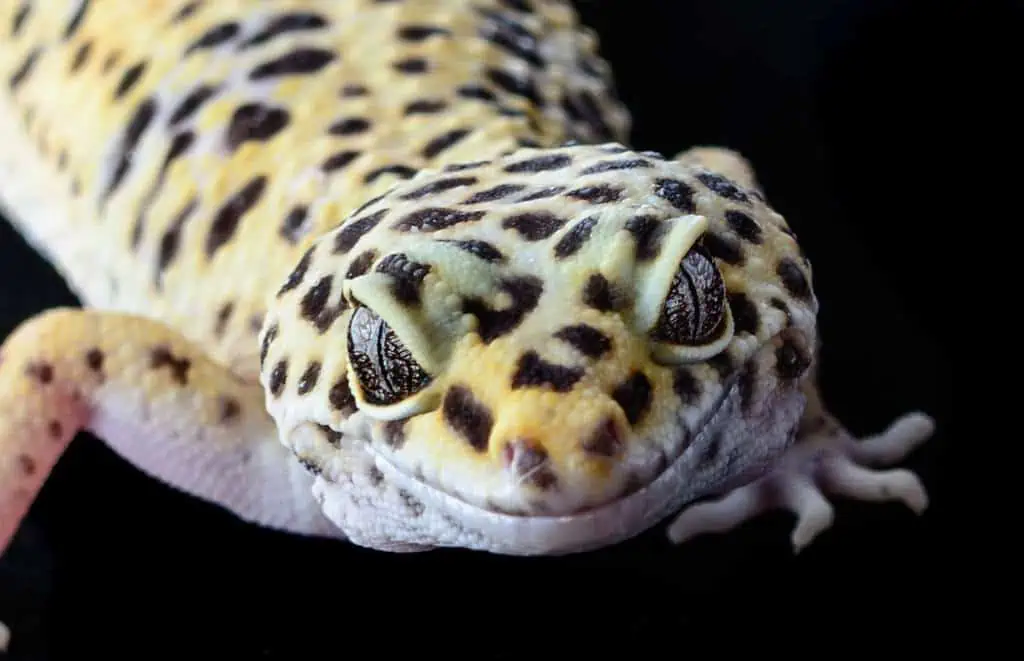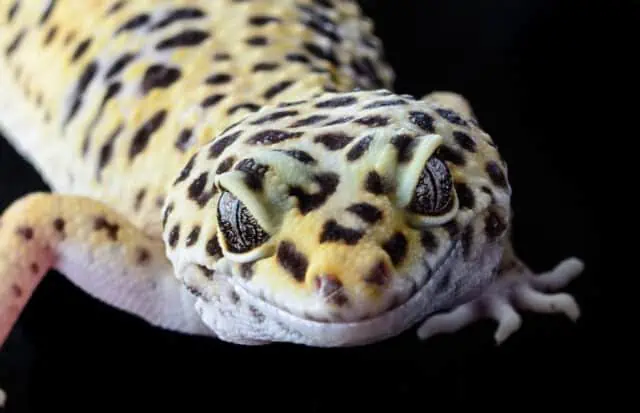Yes, leopard geckos can indeed ingest too much calcium, a condition that is as detrimental to their health as a deficiency. Calcium is an essential nutrient that plays a vital role in many physiological processes, including bone development and muscle function.
An overload of calcium, however, can lead to serious health issues, disrupting the delicate balance of minerals in the gecko’s body and impacting their overall well-being.
Importance of Calcium: Calcium plays a pivotal role in a leopard gecko’s health, especially for strong bone development and muscle functions. An imbalance can lead to conditions like metabolic bone disease.
Balanced Diet is Crucial: Leopard geckos require a balanced diet with the right calcium to phosphorus ratio. Overfeeding calcium-rich foods or feeder insects can disrupt this balance, risking their health.
Symptoms to Watch For: Excessive calcium intake can manifest as lethargy, swollen limbs and joints, poor appetite, and weight loss in leopard geckos.
Environment Matters: Ensure your gecko has proper lighting, especially UVB, and maintain ideal temperature conditions between 88-92°F (31-33°C) for optimal health.
Consult a Veterinarian: If you suspect your gecko has consumed excessive calcium or displays concerning symptoms, a thorough physical examination by a veterinarian is essential.
Can Leopard Geckos Eat Too Much Calcium?
Certainly, leopard geckos can consume excessive amounts of calcium. While calcium is crucial for their bodily functions, it’s a nutrient that must be regulated meticulously. Too much calcium intake can result in a range of health complications and disruptions in their normal bodily processes.
Why Is Calcium Important For Leopard Geckos?
Calcium holds immense importance for leopard geckos, acting as a cornerstone for their overall health and well-being. It is a fundamental nutrient that plays an indispensable role in the formation and fortification of bones, allowing them to maintain strong and resilient skeletal structures.
Without adequate calcium, leopard geckos would be unable to perform essential activities, such as climbing and grasping, due to weakened bones and impaired muscle functions.
Furthermore, calcium is pivotal for the proper functioning of muscles. It assists in the contraction and relaxation of muscles, enabling leopard geckos to move efficiently and hunt their prey. Without sufficient calcium, the muscle functions of these geckos can be severely hampered, affecting their ability to thrive in their natural habitats.
However, a lack of calcium can lead to calcium deficiencies, a severe condition manifesting in myriad health complications. One of the most common ailments stemming from calcium deficiency is metabolic bone disease.
This condition is marked by the weakening and deformation of bones due to insufficient calcium levels, significantly affecting the gecko’s quality of life.
Causes of High Calcium Intake
High calcium intake in leopard geckos can stem from various sources and can lead to a multitude of health problems.
Overfeeding of Calcium-Rich Foods
Overfeeding of calcium-rich foods is a prevalent risk that can jeopardize the health of leopard geckos. These creatures, while requiring calcium, can suffer greatly when presented with an excess of it.
Overconsumption of calcium-rich foods can disrupt the delicate balance between calcium and phosphorus in their bodies. It is crucial to maintain this balance as it plays a pivotal role in their health, supporting both bone strength and metabolic functions.
A disruption in the calcium to phosphorus ratio can lead to severe health issues, most notably metabolic bone disease. This disease is a debilitating condition characterized by weakened, brittle bones, and can severely impact the quality of life of leopard geckos, leading to long-term complications and even reduced lifespan. The disease is not only painful but also impairs mobility and the ability to hunt and feed.
To prevent the complications arising from overfeeding of calcium-rich foods, it is imperative to provide leopard geckos with a balanced and varied diet. Offering a variety of foods ensures that they receive all the necessary nutrients in the right proportions, thus mitigating the risk of excessive calcium intake.
Feeder Insects With High Levels Of Calcium
Leopard geckos often consume a variety of feeder insects that are rich in calcium, such as black soldier fly larvae, silkworms, and butterworms. These insects are particularly sought after due to their high calcium content, providing the essential nutrient needed for the geckos’ bone development and muscle function.
Feeder insects that are high in calcium are a crucial part of the leopard gecko’s diet because they supply the much-needed mineral in a natural and digestible form. Calcium is pivotal for the geckos, helping in the development and maintenance of strong and healthy bones, and aiding muscle functions which are crucial for their mobility and hunting abilities.
Offering calcium-rich foods is particularly important for preventing calcium deficiencies and ensuring the overall well-being of leopard geckos.
However, while these insects are a good source of calcium, it is crucial to maintain a balanced diet to avoid any health issues related to excessive calcium intake.
Unbalanced Diet In Leopard Geckos
Maintaining a balanced diet is paramount for the health and well-being of leopard geckos. An unbalanced diet can lead to a myriad of health issues, including metabolic bone disease and calcium deficiencies.
A well-rounded diet includes a variety of foods to ensure that the geckos receive all the essential nutrients in the correct proportions. We’re talking about insects for the most part, not veggies and lettuce.
The ideal calcium to phosphorus ratio for leopard geckos is around 2:1. Achieving this ratio is crucial as it prevents the development of nutritional imbalances and supports the proper functioning and development of bones and muscles.
Offering a varied diet, including insects like crickets and mealworms, which can be dusted with a calcium supplement, helps in maintaining this balance. While watermelon can be offered occasionally as a treat, it should not form a significant part of their diet due to its low nutrient content.
In addition to providing the right types of food, it’s also vital to consider the amount and frequency of feeding. Overfeeding, even with the right types of food, can lead to obesity and other health issues.
Regular monitoring of the gecko’s weight and body condition, along with adjustments to the diet as needed, can help in maintaining optimal health.
Improper Use Of Supplements And Powders
Improper use of supplements and powders can significantly contribute to excessive calcium intake in leopard geckos. When caregivers fail to follow the proper dosage instructions for these supplements, it can lead to an overdose, causing severe health issues.
Over-supplementation of calcium can disturb the critical balance of minerals in the gecko’s body, leading to complications such as metabolic bone disease and calcium deposits in soft tissues.
Adhering strictly to dosage instructions is crucial to avoid over-supplementation. When used properly, supplements can aid in providing a balanced diet and preventing calcium deficiencies. However, excess calcium intake due to improper supplement use can be detrimental, leading to health complications and impacting the longevity and quality of life of the gecko.
It’s essential to be meticulous with supplement dosages, ensuring the right amount is administered to maintain optimal health and avoid potential risks associated with overdose.
Supplements are intended to fill the gaps in the gecko’s diet and should never be used as a substitute for a balanced, varied diet.
Improper Care And Environment For Leopard Geckos
Improper care and the provision of an unsuitable environment can have severe repercussions for leopard geckos, leading to excessive calcium intake and other health issues.
Inadequate lighting, improper temperature, incorrect humidity levels, and suboptimal substrate choices can all adversely impact the health of leopard geckos. Each of these factors plays a critical role in regulating the gecko’s bodily functions and its ability to metabolize calcium effectively.
Leopard geckos require adequate UVB lighting to synthesize vitamin D3, which is crucial for the absorption and metabolism of calcium. Without proper lighting, the geckos might suffer from calcium deficiencies, prompting the caregiver to overcompensate with calcium supplements, leading to excessive intake.
Similarly, improper temperature and humidity can impair the gecko’s overall health, affecting its digestion and ability to process nutrients, including calcium.
Symptoms Of Excessive Calcium Intake in Leopard Geckos
Identifying symptoms of excessive calcium intake in leopard geckos is crucial to maintaining their health and longevity. An excess of calcium in their diet can manifest in several alarming signs and symptoms that need immediate attention and intervention.
Lethargy and Weakness
Lethargy and weakness are notable symptoms of excessive calcium intake in leopard geckos. Lethargy in geckos is identifiable through observable lack of energy, marked reductions in activity levels, and a pronounced sluggishness.
A gecko experiencing lethargy will often seem uninterested in its surroundings, displaying diminished enthusiasm for food and exploration.
Weakness due to excessive calcium intake can also be prominent, manifesting as difficulty in moving, the occurrence of tremors, and an inability to grip onto surfaces effectively. When geckos exhibit signs of weakness, it can significantly impede their mobility and overall quality of life.
Swollen Limbs and Joints
Swollen limbs and joints in leopard geckos can serve as indicators of several underlying issues, including excessive calcium intake. When a gecko consumes too much calcium, it can lead to the accumulation of mineral deposits within the joints.
This accumulation is problematic as it instigates inflammation and swelling, causing discomfort or pain to the gecko.
Beyond excessive calcium intake, other possible causes for swollen limbs and joints in leopard geckos include metabolic bone disease, a condition stemming from nutritional imbalances, and physical injuries.
Metabolic bone disease can be particularly distressing for geckos, impacting their bone structure and leading to debilitating conditions if not addressed promptly.
Poor Appetite and Weight Loss
When leopard geckos experience excessive calcium intake, they can exhibit symptoms like poor appetite and weight loss. These symptoms are concerning as they can be indicative of underlying health issues.
Excessive calcium can disturb the gecko’s internal balance, making them feel unwell and reducing their desire to eat, which subsequently leads to weight loss.
The reasons behind poor appetite and weight loss in leopard geckos due to excessive calcium intake are multifaceted and interrelated to the overall health of the gecko.
An excess of calcium can lead to complications like gastrointestinal discomfort and kidney problems, both of which can significantly reduce the gecko’s appetite and contribute to weight loss.
Addressing these symptoms involves implementing treatment options and making changes in diet and care to restore balance in calcium levels. Regular veterinary check-ups can assist in monitoring the gecko’s health and adjusting dietary plans accordingly.
Diagnosis Of Excessive Calcium Intake In Leopard Geckos
Determining whether a leopard gecko has ingested too much calcium involves a careful examination of its symptoms, behavior, and living conditions. Excessive calcium intake can lead to serious health issues, so a precise and early diagnosis is critical.
Physical Examination By Veterinarian
When suspecting excessive calcium intake in leopard geckos, a detailed physical examination by a veterinarian is paramount. This process is crucial as it helps in accurately assessing the overall health and body condition of the gecko, providing insights into any underlying issues related to calcium imbalance.
The veterinarian would meticulously observe the leopard gecko, looking for specific signs and symptoms such as lethargy, weakness, swollen limbs, or joints, and changes in appetite or weight.






